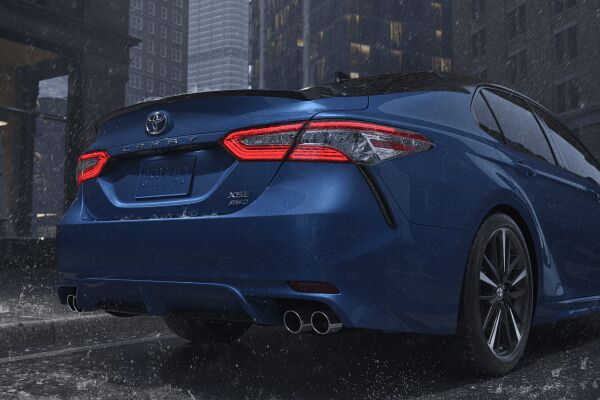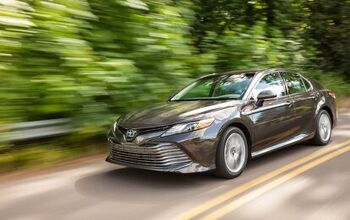Pricing, Fuel Economy Revealed for Toyota Camry AWD

An all-wheel-drive vehicle will reappear early this spring after a decades-long absence, tempting those who demand a sure-footed sedan with untold amounts of badge and nameplate loyalty.
While the Toyota Camry AWD might arrive too late to tackle our current winter, the future is a blank slate, ready to be filled with instances of snow-flinging fun. Perhaps a dirt road race against a Subaru Legacy driver is in the cards.
As the Camry AWD heads to dealerships, Toyota has revealed pricing and fuel economy for the intriguing model.
As reported by Motor1 following a first drive event, adding AWD to either the LE, XLE, SE, or XSE trims is a $1,500 proposition, though changes in content actually makes the difference $1,400 when directly compared. A base Camry LE AWD starts at $26,370 before destination. The sportier (in appearance, mostly) SE starts at $27,570, with the lineup topping out at the $31,405 XSE.
Generally, the AWD models are a carbon copy of what’s offered in FWD; the only difference being a small “AWD” badge and, obviously, the underbody driveline components gathered from the RAV4 and Highlander. The same 2.5-liter four-cylinder and eight-speed automatic can be found in all trims (no V6 option here), though the XSE version makes an extra 3 horsepower (205 hp total) thanks to a dual exhaust.
When announced, Toyota claimed it didn’t expect much of a fuel economy penalty with AWD. An electromagnetically controlled coupling on the front of the rear axle severs the link to the propshaft when the rear wheels aren’t required for motivation, aiding the model’s thirst. That said, the system does automatically engage when starting out from a stop, as that’s when front-end slip would most likely be detected. As well, all AWD models see a slight (0.2-inch) boost in ground clearance.
Figures put out by Toyota now show that the MPG loss isn’t exactly miniscule.
The automaker rates the LE and XLE versions at 25 mpg city, 34 mpg highway, and 29 mpg combined. SE and XSE models see a 1 mpg drop in combined economy, to 28 mpg. In contrast, the FWD Camry LE and SE earn an EPA rating of 28 city, 39 highway, and 32 combined. That’s a 3 mpg combined drop for the base AWD model and a 4 mpg drop for the SE.
The FWD XLE and XSE are rated at 27/38/31, meaning a 2 and 3 mpg combined drop for their AWD counterparts, respectively. If highway cruising’s your bag, LE and SE AWD customers will notice the greatest fuel economy drop — a loss of 5 mpg on the open road.
[Image: Toyota]

More by Steph Willems
Latest Car Reviews
Read moreLatest Product Reviews
Read moreRecent Comments
- Offbeat Oddity The price is definitely too high, but this generation of Accord has still been very reliable- not far off from the Camry. I believe the CVTs in these have held up very well, so while not ideal, it wouldn't deter me- the mileage is just way too high.
- VoGhost "compliance EVs" - so typically Posky. Come on, Matt, come clean about what Big Oil is paying you already.
- VoGhost Great to see leadership from Washington in supporting American businesses and job creation.
- VoGhost Oh, Mattie, I am BEGGING you to take a course in economics. There's probably a community college near you offering courses for free or very cheap. Seriously, people this ignorant of basic economics really should not be writing this drivel. Stick to what you know: pimping for big oil.
- 2manyvettes I was a computer instructor in a local technical college for some years teaching Windows OS and Micosoft Office. Not long before I retired I purchased a Mac Book Air laptop. It didn't take me long to learn the Apple OS and the first thing I learned was the lousy job Microsoft did ripping off the Apple software. I purchased Microsoft Office for Apple at the time and discovered when Apple upgraded the OS to 64 bit and my 32 bit Office software would no longer run on the laptop, that embedded in the Apple OS was software that could open any Office file and could save any file in Microsoft file format. I have always felt if Apple sold product at PC prices they would put Microsoft out of business. Oh, and I bought my Mac ten years ago and still runs like brand new. Effect on Rivian? Who knows? Based on my experience with their technology, it could be interesting.



































Comments
Join the conversation
EPA number decreases and MPG losses, are only tangentially related. Along the lines of EPA numbers = MPG +- 0-20%, depending on how obsessively the tuning has been done specifically to look good on EPA tests. No amount of EPA tweaking a Tundra, will make it match a Prius, but +- 3-5mpg is perfectly achievable by optimizing for EPA.
Observation: Rack up sales increases like Subaru has been doing, and even Toyota will notice. http://carsalesbase.com/us-car-sales-data/subaru/